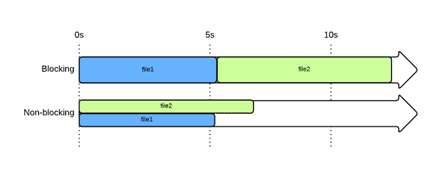Developing a Web-driven application requires some server-side and client – side infrastructure. For many years, the go-to infrastructure referred to as the LAMP stack.
Before introducing MEAN, first we take an overview about existing, current web development stack. It’s LAMP stack. It is a traditional stack, is made up of all free, open-source software elements that work well for Dynamic web sites and applications.
LAMP includes the Linux operating system, PHP application software, MySQL database and the Apache Web server.
 It’s flexible, easy to develop applications with, easy to deploy and customizable, but have some challenges.
It’s flexible, easy to develop applications with, easy to deploy and customizable, but have some challenges.
Web development with LAMP not much faster and more scalable due to its blocking nature. In LAMP we used PHP programming language for server side development.
Programming languages (Java, Ruby, Python, and PHP) that are blocking in nature.
 From a development point of view in LAMP, for frontend, you need JavaScript expert and backend you need is PHP expert. LAMP also features multiple layers of navigation with various configuration files and differing syntax.
From a development point of view in LAMP, for frontend, you need JavaScript expert and backend you need is PHP expert. LAMP also features multiple layers of navigation with various configuration files and differing syntax.
The MEAN stack is a more modern stack that’s challenging the LAMP stack.
MEAN stands for M – Mongo DB as a database system, whereas E – Express as a back-end web framework, where A – Angular.js as a front-end framework and N – Node.js as a back-end runtime environment.
It is completely JavaScript-powered. So that makes it both a time and money-saver for organizations. One common advantage of using JavaScript for both the server and the client is code reuse.
Components of MEAN stack
M – MongoDB
MongoDB is an open source document-oriented database.
It favors a JSON-like document structure rather than the more traditional table-based structures found in relational databases.
Its query language is very powerful and expressive.
E – Express JS
Express JS is a web framework for Node JS.
It is a very transparent web server that allows us to build web applications with Restful JSON APIs.
Express is very modular, so we can modify any requests with middleware.
There are middleware to provide authentication, handling cookies, logging, error handling and other such functions.
A – Angular JS
Angular is an open source JavaScript MVC front-end framework.
This framework enhances the HTML markups with new directives, properties, and tags, and always keeps the views and models in synchronize.
N – Node JS
Node.js is faster and more scalable because of its non-blocking architecture.
Node.JS has an advantage of being event-driven. This allows many concurrent requests with less slowdown.
Node JS package ecosystem, NPM is the largest ecosystem of open source libraries in the world.
Web sockets are simply two-way communications channels between the client and server, Socket.io is one of the most popular Node-based web socket library.
Working with components
- When a client request is received from the user’s browser with angular.js, it hits the Express JS web server first.
- Express JS runs on top of the Node JS platform, and it connects to the MongoDB database as needed.
- Finally, the client’s request is answered with an Angular JS application.
- Angular JS takes care of rendering any new data instantly and avoiding unnecessary full-page refreshes.
Benefits of MEAN
- Node JS is not just a Javascript. It Simplified Server Layer.
- Isomorphic code: JavaScript is the only language used in MEAN stack from server side scripting for Node and Express to client-side scripting using Angular JS.
- Scalability : An application is scalable if it can expand as usage grows and also if it can Perform better with post-expansion.
- Non-blocking architecture: One feature that makes Node more powerful is its non-blocking architecture.
- Development time: In MEAN, JavaScript is used in each component of the stack, so the code is transparent. Transparency in code reduces the effort and the development time.
- Data Transformation: JSON, which is a data interchange format, makes a subset of the JavaScript language.
- High Traffic: Since MongoDB is scalable, it is easy to implement and has the capability to give great back-end storage for high traffic websites
- Extensibility: The MEAN stack provides flexibility in changing the structure of the database. In any module, to add a new feature can be easily achieved via MongoDB documents.
- Performance: Node offers better performance due to its event-driven architecture.
- Web application can be easily modified and maintained.
View this video link https://www.youtube.com/watch?v=9LFsQSNrQ_U to enjoy the journey of MEAN stack web development with simple Poll web application.
Current Market with MEAN
Well-known platforms such as Wikipedia, Facebook, Wallmart, PayPal uses it or started with it.
Area of working
- E-Commerce
- The Internet of Things
- Payment Processing
- Real-time Services
- Social Media
- Media
- Enterprise Web Service
- News feed
- Weather Update
- Game score live update
- Share market
Future Scope with web development stack
Node Js plays an important role in MEAN stack. With Node JS you can create a number of variations of web development stacks.
One variation of the MEAN stack is the MEEN stack which substitutes the Ember.js framework for Angular JS.
You also develop an innovative web application with D3.js, DC.js, Node JS and MongoDB with MEND stack.
Conclusion
LAMP might become outdated in the near future. But it is not the case yet as it is still a reliable player which has established its efficiency over the years. However, the MEAN Stack is surely an innovative, new and cutting-edge technology package that will perhaps conquer the market shortly.
Let’s learn new web technology to develop your innovative ideas…
Connect to our expert web developers.
“The technology keeps moving forward, which makes it easier for the artists to tell their stories and paint the pictures they want. “ – George Lucas
– Priyanka A. Aher








